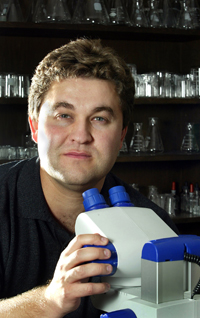Geneticists Work to Map Body Lice Genome
By RICK CALLAHAN
The Associated Press
Thursday, December 8, 2005
 |
Dr. Barry Pittendrigh
Photo by: Tom Campbell,
Purdue Agricultural Communications |
INDIANAPOLIS -- Two Indiana geneticists are playing key roles in a national effort to map the DNA of body lice the tiny, biting insect that spreads typhus in developing nations.
A detailed map of the insect's genome could help researchers develop improved pesticides to control the pest or better drugs to hamper its ability to spread diseases to humans.
Barry Pittendrigh, a Purdue associate professor of entomology, said the body lice genome is the smallest insect genome known to date a fact that could speed along the project.
He is working with fellow geneticist Jeanne Romero-Severson of the University of Notre Dame and four other scientists on the project, which is funded by the National Institutes of Health.
Researchers at several universities are collecting preliminary data on pieces of the insect's DNA, Pittendrigh said. Once those segments are sequenced, they will be assembled into a full genetic map of the insect.
"It will take literally a community to accomplish the annotation of that sequence data and gain a better understanding of its genome," he said.
The mapping project will begin within the next year and take at least two years to complete, said Adam Felsenfeld, program director of the NIH's National Human Genome Research Institute's Large-Scale Sequencing Network.
Preliminary information on segments of the lice genome will be sent to one of five NIH centers, where the actual sequencing of the insect's genetic map will be performed.
Diseases transmitted by body lice are not a serious threat in the United States, but typhus has killed millions in developing nations, particularly during times of war or famine.
The yellowish, rice grain-sized insects are a growing concern in such nations because they are becoming resistant to pesticides.
Aside from typhus, body lice spread relapsing fever, trench fever and other ills by feeding on the blood of human hosts. They are close relatives of head lice, which do not spread disease.
Pittendrigh, the lead author of the proposal for the NIH project, said he will work closely on the project with University of Massachusetts environmental toxicologist John Clark and Spencer Johnson, a Texas A&M geneticist.
They will receive help from Romero-Severson, who directs the Notre Dame-based Indiana Center for Insect Genomics, Si Hyeock Lee of Seoul National University, and Gregory Dasch of the U.S. Centers for Disease Control and Prevention. |